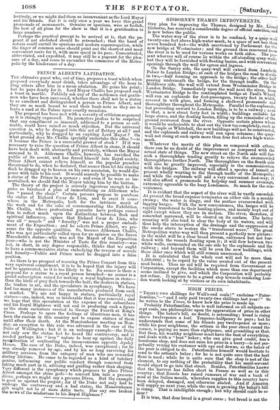GISBORNE'S THAMES IMPROVEAM TS.
ONE plan for improving the Thames, designed by Mr, .11,31141 Gieborne, has received a considerable degree of official sanction; and is now before the public. The water-way of the river is to be confined, by a quay-wail twenty-one feet above high-water-mark, to a space of iaot,less thaa seven hundred feet—the width sanctioned by Parliament for the new bridge at Westminster ; and the ground, thus recovered front the river is to be used for various works on both sides, The pee. sent wharves will of course lie within the .off standing quay-wall; but they will be furnished with floating basins, and with oonvenient openings through the wall for egress and ingress. On the Surrey side, the quay-wall will extend from Lambeth Palace to London Bridge ; at each of the bridges the road to divide in two,—half forming an approach to the bridge • the other half passing underneath the bridge, for the through iraffic. On. the Middlesex side, the wall will extend from Westminster,Bridge to London Bridge. Immediately upon the wall next the river, from Westminster Bridge to the contemplated bridge at- Paul's Wharf, will run an esplanade for foot-passengers, twenty feet in width, covered in with glass, and forming a sheltered promenade and thoroughfare throughout the Metropolis. Parallel to the esplanade, but proceeding onward to London Bridge, is to be a railway ; next to that, a new street forty feet in width ; buildings suitable for large stores, and the floating basins, filling up the remainder of the ground recovered from the river. Opposite certain places where it would be undesirable to shut out the view too completely, such as the Temple or Whitehall, the new buildings will not be constructed, and the esplanade and railway will run upon columns ; the quay. wall not nsing at such spots more than four feet above high-water- mark.
Whatever the merits of this plan as compared with others, there can be no doubt of the improvement as compared with the actual state of things. The new street on the North side will fur- nish a thoroughfare tending greatly to relieve the overcrowded thoroughfares further North. The thoroughfare on the'South side will also be greatly improved, especially in the communication with the bridges. The railway will afford a species of transit at present wholly wanting to the through traffic of the Meteopolis; and while the esplanade will add a very convenient foot-way, it will also afford a promenade for holyday and summer evenings, extremely agreeable to the busy Londoners. So much for the cont, veniences.
It is evident that the aspect of the river will be vastly amended; At present the broad expanse terminates on either side in a muddy swamp ; the water is dingy, and the surface overcrowded with lagging barges. With the new conveniences, the barges will be rapidly transferred to their landing-places, and mainly kept out of sight except where they are in motion. The river, therefore, if somewhat narrowed, will be cleared on its surface. The better scouring will also tend to clear the body of its waters, and will thus help the interception of the drainage and the suppression of the smoke above to restore the " translucent wave." The great Metropolitan water-way will then present a perfectly new picture; in the midst will be a clear broad stream, enlivened but not bur- dened with the vessels floating upon it; it will flow between two white walls, surmounted on the one side by the esplanade and the railway ; and beyond them will be seen the new buildingi, with those older ones which will still remain unscreened.
It is calculated that the whole cost will not be more than 1,500,000/. ; to be repaid by the value created out of the present mud-banks. Thus no aid will be required from Government or Corporation, except the facilities which more than one department seems inclined to give, and which the Corporation will probably not refuse. It appears to be a grand step towards rendering Lon- don worth looking at by visitors or its own inhabitants.


































 Previous page
Previous page